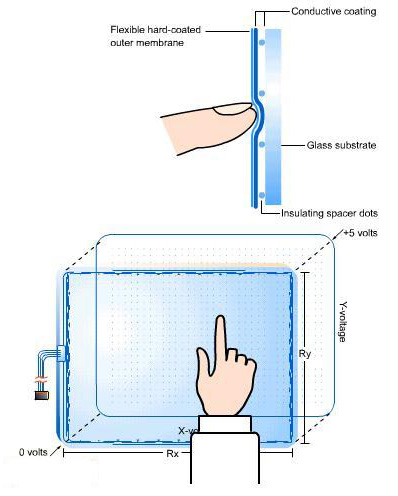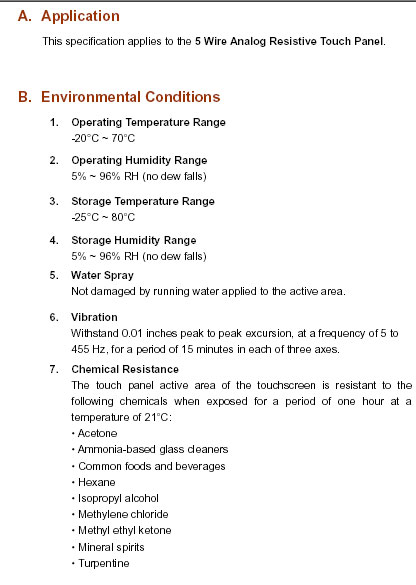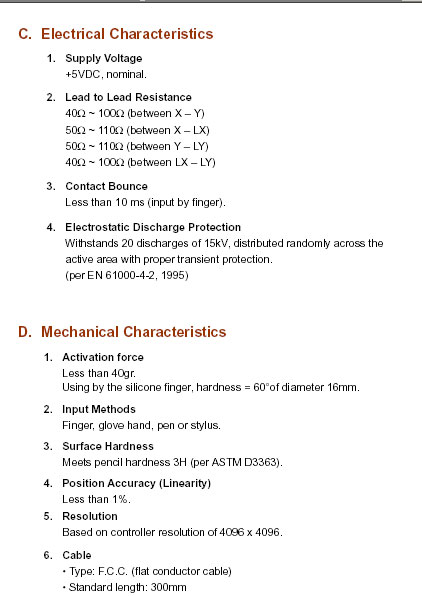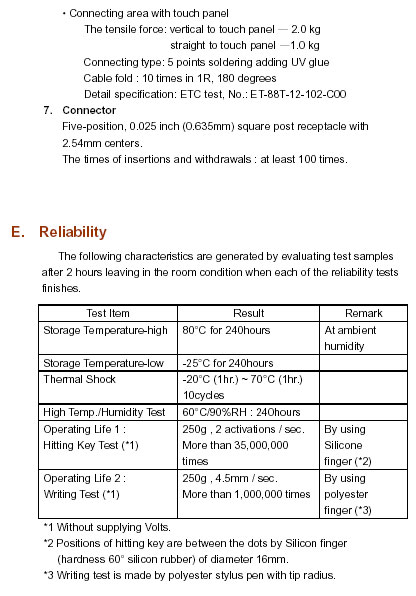How an
Five-Wire Touchscreen Works

Touch screen Parts
The five-wire resistive touch screen uses a
glass panel with a uniform resistive coating. A thick polyester
coversheet is tightly suspended over the top of a glass substrate,
separated by small, transparent insulating dots. The coversheet has
a hard, durable coating on the outer side and a conductive coating
on the inner side.
What Happens During
Touch
When the screen is touched,
it pushes the conductive coating on the coversheet against the
coating on the glass, making electrical contact. The voltages
produced are the analog representation of the position
touched.
How the Touchscreen
Controller Interprets Touch Screen Measurement
When the controller is
waiting for a touch, the resistive layer of the touchscreen is
biased at +5V through four drive lines, and the coversheet is
grounded through a high resistance. When the touchscreen is not
being touched, the voltage on the coversheet is zero. The voltage
level of the coversheet is continuously converted by the
analog-to-digital converter (ADC) and monitored by the
microprocessor on the controller.
When the touchscreen is
touched, the microprocessor detects the rise in the coversheet
voltage and begins converting the coordinates as follows:
|
A
|
The
microprocessor places the X drive voltage on the touchscreen
by applying +5V to pins H and X and grounding pins Y and L. An
analog voltage proportional to the X (horizontal) position of
the touch appears on the cover sheet at pin S of the
touchscreen connector. This voltage is digitized by the ADC
and subjected to an averaging algorithm, then stored for
transmission to the host.
|
|
B
|
Next,
the microprocessor places the Y drive voltage on the
touchscreen by applying +5V to pins H and Y and grounding pin
X and L. An analog voltage proportional to the Y (vertical
position of the touch) now appears on the coversheet at pin S
of the touchscreen connector. This signal is converted and
processed as described above for the X position
|
Why the Averaging
Algorithm is Important
The averaging algorithm
reduces noise resulting from contact bounce during the making and
breaking contact with the touchscreen. Successive X and Y samples
are tested to determine that their values differ by no more than a
certain range. If one or more samples fall outside this range, the
samples are discarded and the process is restarted. This is
continued until several successive X samples (then Y samples) fall
within the range. The average of these values is used as the X and Y
coordinates respectively.
Once independent X and Y
samples are obtained, coordinate pairs are sampled to eliminate the
effects of noise. If a sample does not fall within an internal
range, all X and Y coordinates are discarded and the independent X
and Y sequence is restarted. Once acceptable coordinates have been
obtained, an average coordinate is determined and communicated to
the host processor.
Video
Alignment
The X and Y values are
similar to Cartesian coordinates, with X increasing from left to
right and Y increasing from bottom to top. These absolute
coordinates are arbitrary and unscaled, and will vary slightly from
touchscreen to touchscreen. The 5w. controller can be calibrated for
video alignment. This aligns the touchscreen coordinate system with
the display image, reorients each axis, and scales the coordinates
before they are transmitted to the host computer.
X- and Y-axis Measurements
Originate from the Glass
five-wire technology
utilizes the bottom glass substrate for both X- and Y-axis
measurements. The flexible coversheet acts only as a
voltage-measuring probe. This means that the touchscreen will
continue working properly even with nonuniformity in the cover
sheet's conductive coating. The result is an accurate, durable, and
reliable touchscreen that offers drift free operation.
Specifications for 5Wire Resistive Touch Screen
(5W)




| 
